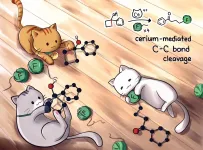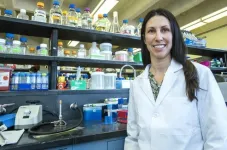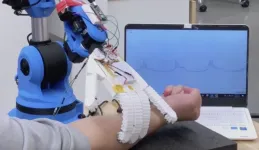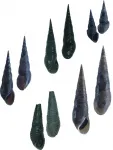(Press-News.org) The ocean floor is vast and varied, making up more than 70% of the Earth's surface. Scientists have long used information from sediments at the bottom of the ocean -- layers of rock and microbial muck -- to reconstruct the conditions in oceans of the past.
These reconstructions are important for understanding how and when oxygen became available in Earth's atmosphere and ultimately increased to the levels that support life as we know it today.
Yet reconstructions that rely on signals from sedimentary rocks but ignore the impact of local sedimentary processes do so at their own peril, according to geoscientists including David Fike in Arts & Sciences at Washington University in St. Louis.
Their new study published Feb. 26 in Science Advances is based on analyses of a mineral called pyrite (FeS2) that is formed in the presence of bacteria. With its chemical-reduced iron (Fe) and sulphur (S), the burial of pyrite in marine sediments is one of the key controls on oxygen levels in Earth's atmosphere and oceans.
The researchers compared pyrite in sediments collected in a borehole drilled in the shelf just off the eastern coast of New Zealand with sediments drilled from the same ocean basin but hundreds of kilometers out into the Pacific.
"We were able to get a gradient of shallow to deep sediments and compare the differences between those isotopic compositions in pyrite between those sections," said Fike, professor of Earth and planetary sciences and director of environmental studies at Washington University.
"We demonstrate that, for this one basin in the open ocean, you get very different signals between shallow and deep water, which is prima facie evidence to argue that these signals aren't the global fingerprint of oxygen in the atmosphere," said Fike, who also serves as director of Washington University's International Center for Energy, Environment and Sustainability (InCEES).
Instead of pointing directly to oxygen, the same signals from pyrite could be reinterpreted as they relate to other important factors, Fike said, such as sea level change and plate tectonics.
Fike and first author Virgil Pasquier, a postdoctoral fellow at the Weizmann Institute of Sciences in Israel, first questioned the way that pyrite has been used as a proxy in a study published in PNAS in 2017 using Mediterranean Sea sediments. For his postdoctoral research, Pasquier has been working with professor Itay Halevy at the Weizmann Institute to understand the various controls on the isotopic composition of pyrite. Their results raise concerns about the common use of pyrite sulfur isotopes to reconstruct Earth's evolving oxidation state.
"Strictly speaking, we are investigating the coupled cycles of carbon, oxygen and sulfur, and the controls on the oxidation state of the atmosphere," Pasquier said.
"It's much more sexy for a paper to reconstruct past changes in ocean chemistry than to focus on the burial of rocks or what happened during the burial," he said. "But I find this part even more interesting. Because most microbial life -- especially back when oxygen was initially accumulating in the atmosphere -- occurred in sediments. And if our ultimate goal is to understand oxygenation of the oceans, then we have to understand this."
For this study, the team conducted 185 sulfur isotope analyses of pyrite along the two boreholes. They determined that changes in the signals in pyrite from the nearshore borehole were more controlled by sea level-driven changes in local sedimentation, rather than any other factor.
In contrast, sediments in the deeper borehole were immune to the sea-level changes. Instead, they recorded a signal associated with the long-term reorganization of ocean currents.
"There is a water depth threshold," said Roger Bryant, a co-author and PhD graduate of Fike's laboratory at Washington University, now a postdoctoral fellow at the University of Chicago. "Once you go below that water depth, sulfur isotopes apparently are not sensitive to things like climate and environmental conditions in the surface environment."
Fike added: "The Earth is a complicated place, and we need to remember that when we try to reconstruct how it has changed in the past. There are a number of different processes that impact the kinds of signals that get preserved. As we try to better understand Earth's long-term evolution, we need to have a more nuanced view about how to extract information from those signals."
INFORMATION:
Cells rely on membranes to protect themselves from the outside world. But these membranes can't be fully closed because nutrients and other molecules have to be able to pass through. To achieve this, cell membranes have many types of channels and pores. Also, there are receptors, antennas if you like, imbedded in the membrane that continuously monitor the outside world and signal to the cell interior. Extensive collaboration between five VIB groups resulted in a better understanding of the machinery that plants use to regulate the protein composition of their outer membrane. This discovery, published in Science Advances, enhances our basic knowledge of how the plasma membrane composition can be adapted based on external stimuli, an essential ...
A team of international researchers went back to the formation of the solar system 4.6 billion years ago to gain new insights into the cosmic origin of the heaviest elements on the period-ic table.
Led by scientists who collaborate as part of the International Research Network for Nuclear Astrophysics (IReNA) (irenaweb.org) and the Joint Institute for Nuclear Astrophysics - Center for the Evolution of the Elements (JINA-CEE) (jinaweb.org), the study is published in the lat-est issue of the journal Science (science.sciencemag.org/content/371/6532/945).
Heavy elements we encounter in our everyday life, ...
HOUSTON - (Feb. 26, 2021) - Save your silver! It's better used for jewelry than as a catalyst for drugs.
Rice University scientists have developed a greatly simplified method to make fluoroketones, precursors for drug design and manufacture that typically require a silver catalyst.
Rice chemist Julian West and graduate students Yen-Chu Lu and Helen Jordan introduced a process for the rapid and scalable synthesis of fluoroketones that have until now been challenging and expensive to make.
Their open-access work graces the cover of the Feb. 21 issue of the Royal Society of ...
Dropping out of high school, having schizophrenia, or being diagnosed with a co-occurring personality disorder increases the likelihood of someone becoming a "high utilizer" of inpatient psychiatric hospital services, according to a new study by researchers at The University of Texas Health Science Center at Houston (UTHealth). A high utilizer is someone who has been admitted three or more times within one year.
The research was published today in The Journal of Health Care for the Poor and Underserved.
For their findings, researchers used machine learning to analyze deidentified electronic ...
MISSOULA - University of Montana researchers and their partners have discovered a slimy strategy used by bacteria to defeat antibiotics and other drugs used to combat infections afflicting people with cystic fibrosis. The research was published Feb. 23 in the journal Cell Reports.
Cystic fibrosis is a life-threatening disease that causes persistent lung infections and limits a person's ability to breathe over time. A common strain of bacteria, Pseudomonas aeruginosa, often thrives in the lungs of people with cystic fibrosis, as well as in wounds from burns or diabetic ulcers. Once a P. aeruginosa infection is established, ...
Robots that could take on basic healthcare tasks to support the work of doctors and nurses may be the way of the future. Who knows, maybe a medical robot can prescribe your medicine someday? That's the idea behind 3D structural-sensing robots being developed and tested at Simon Fraser University by Woo Soo Kim, associate professor in the School of Mechatronic Systems Engineering.
"The recent pandemic demonstrates the need to minimize human-to-human interaction between healthcare workers and patients," says Kim, who authored two recent papers on the subject - a perspective on the technology and a demonstration of a robots' usefulness in healthcare. "There's an opportunity for sensing robots to measure ...
Parasitic flatworms known as agents of food-borne zoonoses were confirmed to use several species of thiarid snails, commonly found in freshwater and brackish environments in southeast Asia, as their first intermediate host. These parasites can cause severe ocular infections in humans who consume raw or improperly cooked fish that have fed on infected snails. The study, conducted in South Thailand by Thai and German researchers and led by Kitja Apiraksena, Silpakorn University, is published in the peer-reviewed open-access journal Zoosystematics and Evolution.
"Trematode infections are major public health problems affecting humans in southeast Asia," explain the scientists. "Trematode infections depend not only on the habit of people, but also on the presence of first ...
BOSTON - Two novel calculators for predicting which patients admitted to the hospital with COVID-19 are at greatest risk of requiring mechanical ventilation or of in-hospital death have been developed and validated by Massachusetts General Hospital (MGH). In a study published in The Lancet's EClinicalMedicine, researchers describe how these models could enable clinicians to better stratify risk in COVID-infected patients to optimize care and resource utilization in hospitals faced with ICU capacity constraints.
"Information that can accurately predict severity of the clinical course at the time of hospital admission has been limited," says senior author Rajeev Malhotra, MD, a cardiologist at MGH and investigator in the MGH Cardiovascular Research Center. ...
COLUMBIA, Mo. -- When Patrick Rottinghaus began college, he had no idea what he wanted to do with his career. He started out as an "Open" major while he explored possibilities.
Today, Rottinghaus, an associate professor in the University of Missouri College of Education, is helping young people eager to find their place in the world by identifying their strengths and connecting them with careers that match their skillset, interests and personality. As the father of three children, including a daughter soon to enter high school, he wants to ensure they are equipped ...
In recent years, engineers have found ways to modify the properties of some "two- dimensional" materials, which are just one or a few atoms thick, by stacking two layers together and rotating one slightly in relation to the other. This creates what are known as moiré patterns, where tiny shifts in the alignment of atoms between the two sheets create larger-scale patterns. It also changes the way electrons move through the material, in potentially useful ways.
But for practical applications, such two-dimensional materials must at some point connect with the ordinary world of 3D materials. An international team led by MIT researchers has now come up with a way of imaging what goes on at these ...






